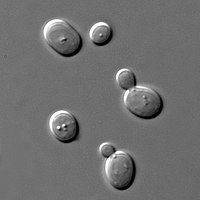
Photo from wikipedia
Sake is a traditional Japanese alcoholic beverage made from rice and water, fermented by the filamentous fungi Aspergillus oryzae and the yeast Saccharomyces cerevisiae. Yeast strains, also called sake yeasts,… Click to show full abstract
Sake is a traditional Japanese alcoholic beverage made from rice and water, fermented by the filamentous fungi Aspergillus oryzae and the yeast Saccharomyces cerevisiae. Yeast strains, also called sake yeasts, with high alcohol yield and the ability to produce desired flavor compounds in the sake, have been isolated from the environment for more than a century. Furthermore, numerous methods to breed sake yeasts without genetic modification have been developed. The objectives of breeding include increasing the efficiency of production, improving the aroma and taste, enhancing safety, imparting functional properties, and altering the appearance of sake. With the recent development of molecular biology, the suitable sake brewing characteristics in sake yeasts, and the causes of acquisition of additional phenotypes in bred yeasts have been elucidated genetically. This mini-review summarizes the history and lineage of sake yeasts, their genetic characteristics, the major breeding methods used, and molecular biological analysis of the acquired strains. The data in this review on the metabolic mechanisms of sake yeasts and their genetic profiles will enable the development of future strains with superior phenotypes.
Journal Title: FEMS yeast research
Year Published: 2022
Link to full text (if available)
Share on Social Media: Sign Up to like & get
recommendations!